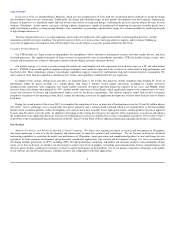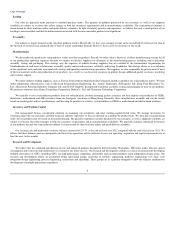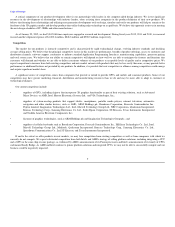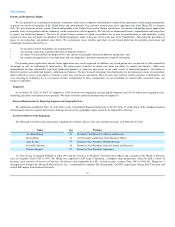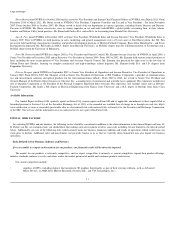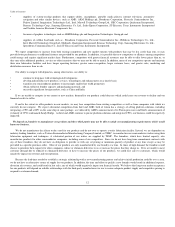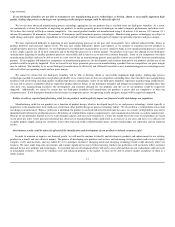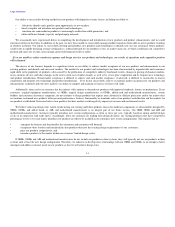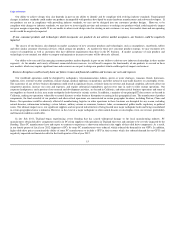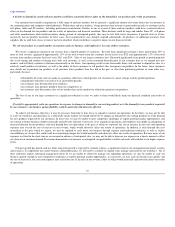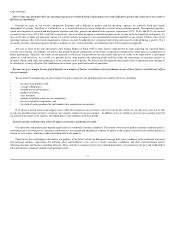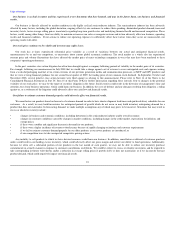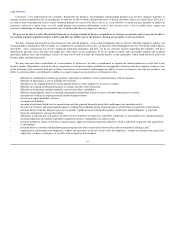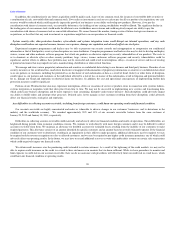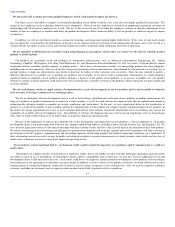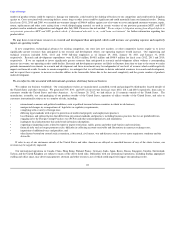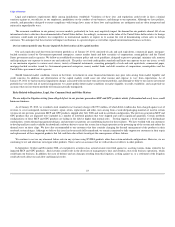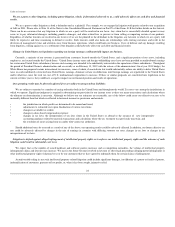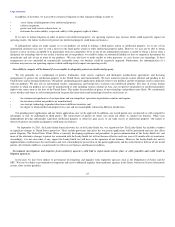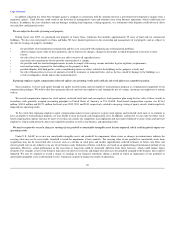NVIDIA 2012 Annual Report Download - page 17
Download and view the complete annual report
Please find page 17 of the 2012 NVIDIA annual report below. You can navigate through the pages in the report by either clicking on the pages listed below, or by using the keyword search tool below to find specific information within the annual report.
Table of Contents
A decline in demand in certain end-user markets could have a material adverse effect on the demand for our products and results of operations.
Our customer base includes companies in a wide range of end-user markets, but we generate a significant amount of revenue from sales to customers in
the communications-and computer-related industries. Within these end-user markets, a large portion of our revenue is generated from sales to customers in the
cell phone, tablet and PC markets, including professional workstations. Decline in one or several of these end-user markets could have a material adverse
effect on the demand for our products and our results of operations and financial condition. These declines could be large and sudden. Since PC, cell phone
and tablet manufacturers often build inventories during periods of anticipated growth, they may be left with excess inventories if growth slows or if they
incorrectly forecast product transitions. In these cases, these manufacturers may abruptly suspend substantially all purchases of additional inventory from
suppliers like us until their excess inventory has been absorbed, which would have a negative impact on our financial results.
We sell our products to a small number of customers and our business could suffer if we lose any of these customers.
We receive a significant amount of our revenue from a limited number of customers. Revenue from significant customers, those representing 10% or
more of total revenue, aggregated approximately 11% of our total revenue from one customer for the fiscal year 2012 and approximately 12% of our total
revenue from another customer for fiscal years 2011 and 2010. Sales to our largest customers have fluctuated significantly from period to period primarily
due to the timing and number of design wins with each customer, as well as the continued diversification of our customer base as we expand into new
markets, and will likely continue to fluctuate dramatically in the future. Our operating results in the foreseeable future will continue to depend on sales to a
relatively small number of customers, as well as the ability of these customers to sell products that incorporate our products. In the future, these customers
may decide not to purchase our products at all, purchase fewer products than they did in the past, or alter their purchasing patterns in some other way,
particularly because:
• substantially all of our sales are made on a purchase order basis, which permits our customers to cancel, change or delay product purchase
commitments with little or no notice to us and without penalty;
• our customers may develop their own solutions;
• our customers may purchase products from our competitors; or
• our customers may discontinue sales or lose market share in the markets for which they purchase our products.
The loss of any of our large customers or a significant reduction in sales we make to them would likely harm our financial condition and results of
operations.
If we fail to appropriately scale our operations in response to changes in demand for our existing products or to the demand for new products requested
by our customers, our business and profitability could be materially and adversely affected.
To achieve our business objectives, it may be necessary from time to time for us to expand or contract our operations. In the future, we may not be able
to scale our workforce and operations in a sufficiently timely manner to respond effectively to changes in demand for our existing products or to the demand
for new products requested by our customers. In that event, we may be unable to meet competitive challenges or exploit potential market opportunities, and
our current or future business could be materially and adversely affected. Conversely, if we expand our operations and workforce too rapidly in anticipation of
increased demand for our products, and such demand does not materialize at the pace at which we expected, the rate of increase in our costs and operating
expenses may exceed the rate of increase in our revenue, which would adversely affect our results of operations. In addition, if such demand does not
materialize at the pace which we expect, we may be required to scale down our business through expense and headcount reductions as well as facility
consolidations or closures that could result in restructuring charges that would materially and adversely affect our results of operations. Because many of our
expenses are fixed in the short-term or are incurred in advance of anticipated sales, we may not be able to decrease our expenses in a timely manner to offset
any decrease in customer demand. If customer demand does not increase as anticipated, our profitability could be adversely affected due to our higher expense
levels.
Our past growth has placed, and any future long-term growth is expected to continue to place, a significant strain on our management personnel, systems
and resources. To implement our current business and product plans, we will need to continue to expand, train, manage and motivate our workforce. All of
these endeavors require substantial management effort. If we are unable to effectively manage our expanding operations, we may be unable to scale our
business quickly enough to meet competitive challenges or exploit potential market opportunities, or conversely, we may scale our business too quickly and
the rate of increase in our costs and expenses may exceed the rate of increase in our revenue, either of which would materially and adversely affect our results
of operations.
16


